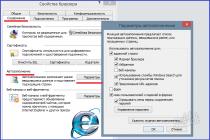Not every user of mobile devices knows that in most devices on Android base there is such an interesting thing as a barometer. Why is it needed on the phone? Is it really just to measure atmospheric pressure? In fact, this sensor is part of the GPS system and allows you to determine geolocation with maximum accuracy.
But, of course, nothing prevents us from using the barometer for its intended purpose. All that is required for this is to install a special program from the store Google play... Below are some of these applications.

The app deserves to be at the top of our list. The program has all the necessary functions and a user-friendly interface. It has its own widget that shows not only the current pressure, but also. If desired, you can set up automatic display of notifications on the display of your smartphone. Alerts of upcoming natural surprises will be displayed as an icon in the notification bar. Unfortunately, latest version SyPressure has an annoying bug: in the settings, sound warnings have started to turn on by themselves, and the phone can sometimes ring at the most inopportune time.
At the top of the program window, the atmospheric pressure at the current time is displayed. You can choose from possible ways information output: scale, diagram or graph. The units of measurement can also be customized as you like: hPa (hectopascal), inHg (inch of mercury), mmHg (millimeter of mercury), psi (pounds per square inch), atm (physical atmosphere). At the bottom of the window, you can see the pressure fluctuations (rise / fall) and the expected weather changes. The notification settings panel is also located here.


The paid program is another useful tool for measuring atmospheric pressure and compared to SyPressure, it has more settings. Several options for displaying information are supported: indicator, graph, altimeter and list. In addition, the widgets displayed on the screen are varied in size: 1 × 1, 2 × 1, 2 × 2.
In the application, any of the functions can be configured extremely accurately. For example, in order to get more reliable weather reports, you should specify the baseline measurements for your location, and for an altimeter (altimeter) - the height above sea level. The pressure change graph can be used to set the desired display period (from 6 to 48 hours).
Here you can also choose the color of the main interface and indicators, change the transparency of the widgets. Like SyPressure, this tool works in a variety of units. In general, quite pleasant impressions are left from using the program. She, without a doubt, justifies its cost of 40 rubles.
Barometer reborn


Barometer Reborn is a simple barometer that allows you to track the amplitude of changes in atmospheric pressure in order to determine the effect of these factors on your well-being. This can be useful for those of us who experience headaches and other discomfort when the weather conditions change.
Knowing in advance about the upcoming natural metamorphoses, you can try to reduce their unpleasant effect to a minimum. For example, if the device shows an increase in atmospheric pressure, then on such days it is worth giving up increased physical activity. First of all, it is important for people suffering from respiratory diseases (such as asthma) or hypertension. On the contrary, a decrease in pressure should be a reason to spend more time outdoors.
Barometer & Altimeter


Barometer & Altimeter - the program uses a built-in GPS sensor (if there is none, it receives information from the Internet). You will be able to track atmospheric pressure, air temperature, wind speed, visibility, altitude. This information will certainly provide invaluable assistance to fans of extreme sports, tourists and travelers.
Agree that this is enough interesting application and definitely deserves attention. Imagine how great it would be to set up a barometer and, having climbed onto the roof of a skyscraper, you can easily determine the altitude and atmospheric pressure.
The program is not demanding on the phone's memory resources and is very gentle on the battery power. The interface is as convenient as possible, the settings are not complicated. Young researchers of natural phenomena, using this tool, will be able to conduct the first scientific experiments, satisfy their curiosity and thirst for knowledge.
mu Barometer


mu Barometer is a free and very simple tool that records changes in barometric pressure readings. The app is different elegant design and a user-friendly interface, uses such measuring units as mBar, mmHg, inHg, atm.
You can choose one of the three suggested themes for the widget displayed on main screen phone. The program also allows you to measure and height (in meters or feet).
eWeather HD


EWeather HD app is a complete weather station for your Android. Here you will find detailed information on natural phenomena for the next 10 days. The first thing that attracts attention is the amazingly beautiful images of the sun and clouds. Looking at them, you forget what purpose you pursued by opening this program. But in addition to colorful drawings, there are a lot of other functions, and the forecasts are extremely accurate.
The main screen of the weather display contains a lot of useful information: humidity, pressure, temperature (real and perceived), sunrise and sunset times, moon phases, temperature change diagrams, precipitation probability, geomagnetism ... By the way, the last parameter should be paid attention to meteorological people. If geomagnetic storms bother you, before starting important business, do not forget to read the forecast.
Equally, this information will be useful to everyone who reacts painfully to the approach of a thunderstorm, precipitation and other natural phenomena. You will be able to observe changes in atmospheric pressure over the past 24 hours on a chart or graph, where, in case of unfavorable indicators, the indicator turns red.
It is impossible to list all the features of this wonderful application, the interface of which looks really cool in terms of graphic design.
According to medical statistics, more than half of the inhabitants of our planet react in one way or another to changing weather conditions. For some, these changes are almost imperceptible, while others, on the contrary, can hardly tolerate surges in atmospheric pressure, bursts of solar activity and magnetic storms. In addition, the vagaries of the weather often cause a deterioration in well-being in people with chronic diseases of the joints and cardiovascular system, suffering from hypertension or arterial hypotension.
Knowing ahead of time about the upcoming changes, you can try to minimize their negative impact on health. To always have at hand necessary information, you just need to install one of the applications described above on your smartphone.
Windows 10 monitors each user - all his requests and location, smartphones are not even discussed - they show the owner's route and the altitude (floor) on which he is located and the geodata and knows your requests - and can also record your voice without your knowledge , take your photos, and send your fingerprints and scanned retinas to third parties
Despite their modest size, modern smartphones are very complex devices with powerful multi-core processors, autofocus cameras and optical stabilization, high resolution screens with high ppi values. In addition, any smartphone is equipped with various sensors that make using the device more convenient, or, especially in top-end gadgets, expand their capabilities. In our today's material, we will focus specifically on sensors, which of them can be found in modern gadgets, as well as how and for what they are used.
The first sensor to be widely used in smartphones is accelerometer, which used to be also often called G-sensor... As the name implies, this sensor is used to measure the acceleration of the device along three axes. Obviously, there is acceleration only when the device moves or rotates in space, so the accelerometer cannot determine the position of a stationary smartphone. This means that its accuracy, for example, in games, will be relatively low.
To neutralize this disadvantage of the accelerometer, together with it, in the vast majority of modern devices, including the most budgetary ones, it is used gyroscope... Unlike an accelerometer, a gyroscope can determine the position in space (tilt angle along three axes) even of a stationary device. The error of a calibrated gyroscope in modern smartphones, as a rule, does not exceed 1-2 degrees. The gyroscope and accelerometer are widely used in many mobile games for management, as well as in other applications - with a variety of tasks.
The next sensor, which can also be found in almost every smartphone - magnetometer... This sensor reacts to the earth's magnetic field and thus allows the cardinal directions to be determined. This, in turn, along with data on cell towers and Wi-Fi hotspots in sight, is used when navigating in the absence of a GPS signal. The magnetometer is a sensitive sensor, and therefore, with a smartphone with it, you can, for example, look for wiring in the wall, if it is shallowly walled up - just download an application that will read the sensor readings.
Almost every modern smartphone is also not complete without proximity sensor... The sensor is an infrared emitter with a receiver hidden under the front glass of the device. He can detect the presence of an object in front of him at a distance of about five centimeters. Thanks to this sensor, it is enough to bring the smartphone to your ear during a call - and the display will turn off automatically (just as it will turn on if you remove the device); there is no need to use the power button for this. It is worth mentioning that some of Samsung's top smartphones use an advanced proximity sensor that functions as gesture sensor responding to various movements of the hand above it.
Many smartphones, with the exception of budget models, are equipped with light sensors... The main purpose of this sensor is to determine the level of ambient light and adjust the brightness of the display backlight in accordance with it.
At this point, the list of common sensors can be considered complete. As you can see, most smartphones have at least five useful sensors, but many other sensors can be found in more advanced gadgets. One of them - barometer... Despite the fact that it first appeared in a smartphone Samsung Galaxy Note a few years ago, until now it can be found only in some devices of the middle and top segments. Like the magnetometer, the barometer helps the device navigate the terrain faster and pick up the signal from GPS satellites. Of course, by downloading one of the many free apps, you can use the barometer for its intended purpose - to recognize the atmospheric pressure in pascals or millimeters of mercury. It is also possible to use the barometer as altimeter- a device that measures altitude above sea level. True, the accuracy of its readings in this case is noticeably influenced by fluctuations in atmospheric pressure, but this is regulated by entering current meteorological data and a control altitude point for a specific area.
V smartphone Samsung Galaxy S4 first appeared thermometer... The use of this sensor is more than obvious: using preinstalled app S Health (however, you can also download one of third-party programs from Google Play), the user can recognize the ambient temperature. The same can be said for the humidity sensor - hygrometer, which also first appeared on the Samsung Galaxy S4 and can be used in conjunction with the S Health app.
A Hall sensor is used to operate Smart Covers, when opened, the screen of the device automatically turns on. Like a magnetometer, Hall Sensor reacts to a magnetic field, but, unlike the first, has a simpler principle of operation: it does not determine the strength of the magnetic field along several axes, but simply reacts to its amplification caused by the approach of a permanent magnet hidden in the cover.
Modern gadgets have long learned to perform the functions of a pedometer, but usually an accelerometer is used for this. One of the few devices with pedometer in the form of a separate sensor, the smartphone LG Nexus 5 has become. While such a sensor is a curiosity, but most likely it will soon be used in other devices.
Another rare sensor - heart rate monitor... At the moment, a separate sensor for measuring heart rate can only be found in the Samsung Galaxy S5 and Samsung Galaxy S5 Active smartphones (not counting smart watch the same company under Android and Tizen).
A slightly more common sensor is Fingerprint's scanner allowing you to quickly unlock your device without having to enter a password. Today this sensor is used in Apple iPhone 5S, Samsung Galaxy S5, Htc one Max and a few more uncommon smartphone models. Nevertheless, the first device, the iPhone 5S, is rightfully considered the benchmark for its implementation.
On this, perhaps, a long list of sensors can be completed, but in the end we still left a sensor that is completely outlandish for a smartphone - dosimeter... It is known for certain that the Pantone 5 107SH released in Japan is equipped with it - probably after the notorious accident at a nuclear power plant in the Land of the Rising Sun, they began to closely monitor the radiation situation around.
As a small conclusion, we will repeat: almost any more or less modern gadget is equipped with at least five different sensors. The absolute record holder for their number can be called the Samsung Galaxy S5, which, according to our calculations, has as many as 12 sensors. How many sensors have you counted on your smartphone?
V modern telephones installed many sensors, including a barometer. Their goal is to make the life of device owners more comfortable. Smartphone pressure measuring device - part navigation system- it helps to accurately and quickly determine the location of the user. And to use it for its intended purpose, the owner installs additional applications.
The barometer in the device: what is it and why is it needed
In the original, the device was created to measure atmospheric pressure in order to make a more accurate weather forecast based on its readings. For example, if bad weather is replaced by clear sunny days, the barometer rises. Since most of the world's population, according to medical statistics, reacts to a change in weather to one degree or another, knowing about future changes, the negative impact can be reduced to almost zero. This is especially true for people suffering from heart disease, joints
The barometer in the phone, or rather the ambient pressure sensor, allows you to minimize stress for the body due to pressure drops. In addition, in the gadget, it is primarily a part of the navigator that allows you to quickly determine the location. To operate the device, a connection with a satellite and an Internet connection are established.
For your information!
The first device to measure atmospheric pressure was seen in Italy in the middle of the 16th century. The mercury column design was so successful that it is still used today in synoptic centers.
Is there a device in the smartphone

Engineering services often equip devices with measurement sensors. Among the most common are the following models: Samsung Galaxy Note, S3 and Nexus, Motorola Xoom, Sony ericsson Active and Xiaomi Phone 2. Sensors can also be built into other communication devices. Although this does not happen very often.
There are three methods to determine that a smartphone has a similar option, or rather a sensor is installed. To find out if it is possible to measure atmospheric pressure using a gadget, you need to do the following:
- Look official characteristics phone.
- Download special utility AnTuTu. After launching the application, in the "My device" section, you can see a list of all built-in sensors.
- Install the Datchecker program. Like the previous application, it allows you to see all the sensors that engineers have equipped the device with, including the atmospheric pressure sensor.
Barometer apps for Android
If the phone is equipped with an appropriate sensor, so that the latter fulfills its original option and demonstrates fluctuations in the ambient pressure, a special software is installed. You can do this on Google Play. The reviews present the following utilities:
- SyPressure;
- Precise Barometer;
- vBarometer;
- Pressure tracker.
For your information!
There are programs that notify users about changes in atmospheric pressure, even if there is no measuring sensor on the smartphone. The applications provide a link to information received from the nearest weather stations.
SyPressure
A utility with broad functionality and an intuitive interface. After launch, you can see a widget showing the current pressure and making a prediction. If the user wants, he can activate notifications about weather changes in the near future. If earlier messages were displayed in the notification panel at the request of the owner, now there is a flaw in the software: notification with sound signal may come on its own at the most inopportune time. If you use the professional version (paid), an altimeter is also available. There is no additional option in the free option.
vBarometer

Paid utility with a more extensive list of options. You can select visualization elements: indicator, chart, etc. The dimensions of the interface are optional. Several options are available. Application applicable different units measurements. The user changes the color of the graphics as he wishes - up to the transparent version (the most popular).
The barometer in phones is a useful sensor that makes life more comfortable, especially for people who experience great discomfort during a change in the weather. If necessary, it can turn into a navigator.
#Phone_Sensors #Tablet_SensorsThe presence of many sensors in modern mobile devices, this is a known fact, but how many of them and what these sensors are used for is a mystery. Many manufacturers indicate only the main well-known sensors in phones like accelerometer, gyroscope and proximity sensor... But the overwhelming majority of manufacturers write little at all about the sensors used and other electronics that are stuffed with their device.
We decided to clarify the situation with the sensors of smartphones and tablets. The purpose of the article is to tell you what sensors are, what they serve, in which devices they can be found and how.
Sensors are called various devices reading additional information. These solutions make working with a phone, tablet or other gadget more convenient and add functionality to the device.
The presence of many sensors in modern mobile devices is a known fact, but how many of them and what these sensors are used for is a mystery. Many manufacturers list only the main well-known sensors, such as the accelerometer, gyroscope and proximity sensor. But the overwhelming majority of manufacturers write little at all about the sensors used and other electronics that are stuffed with their device.
We decided to clarify the situation with the sensors of smartphones and tablets. The purpose of the article is to tell you what sensors are, what they serve, in which devices they can be found and how.
Essential sensors in smartphones and tablets
Accelerometer
(accelerometer, orientation sensor, acceleration sensor)- the simplest sensor found in any smartphone or tablet. Serves mainly for registering the rotation of the smartphone from portrait to landscape orientation. Often, it is the accelerometer that is called the G-Sensor. In general, the accelerometer registers the difference between the acceleration of an object and the gravitational acceleration along three axes. The electronics then calculates the difference, draws conclusions and sends a signal software- when and in which direction to turn the screen. Hence the main disadvantage of the accelerometer - if there is no acceleration or it is not great, then the accelerometer stops registering the position of the device in space or does it with a large error. This negatively affects the accuracy of control of the device, for example, in games or when controlling a quadcopter. This is where the next sensor comes in.
Gyroscope
(gyroscope)- also serves to register the position of the device in space, but, unlike an accelerometer, it can register the angle of inclination along three axes of even a stationary device. With the help of a gyroscope in games, accuracy is increased, since developers will have access to information about the deviation of the device in degrees with an error of only 1-2 degrees. Many believe that even inexpensive smartphones and tablets are equipped with a gyroscope. However, our experiment showed that inexpensive smartphones and tablets cannot boast of the presence of a gyroscope - only an accelerometer. Here are some smartphones and tablets where the gyroscope could not be detected:We also did not find a gyroscope in,
And here's where the notorious sensor is:
We also found a gyroscope in,. And there is no doubt that the gyroscope and a solid set of other sensors are contained in TOP solutions like other best modern smartphones.
Surprisingly, in the LG G4S and Asus FonePad 8 (about which we already wrote -) the gyroscope is not visible in the list of sensors, but there are a lot of auxiliary sensors:
For the sake of fairness, it should be noted that the auxiliary sensors, which we considered at the very end of the article, can neutralize the absence of a gyroscopic sensor, but, we believe, not completely.
Geomagnetic sensor
(geomagnetic field sensor, magnetometer)- a sensor that responds to magnetic fields land. It can be used to determine the cardinal points, which is why it is often called an electronic compass. In particular, the presence of such a sensor will greatly help devices without GPS module determine the location (not without the help of WiFi and towers cellular, of course). The magnetometer is one of the key sensors that, together with the accelerometer and gyroscope, enables developers to use the device at full capacity. Sometimes, to further improve accuracy, additional hardware sensors are added with similar but simplified functionality like the Geomagnetic Rotation vector sensor. Naturally, the magnetometer can be used for its intended purpose: as a metal detector, to search for wiring in the walls, as a compass - look for what you need in app stores.
Some smartphone apps using the geomagnetic sensor
Proximity sensor
(proximity sensor)- the sensor allows you to determine the object in front of you and the distance to it. It is an infrared emitter and receiver. When no radiation arrives at the receiver, there is no object, and when it does, there is an object from which the beam is reflected. This sensor makes it possible to turn off the display when you bring your ear close to the smartphone to make a call. Advanced versions of the sensor are used as a gesture sensor - a smartphone can recognize certain hand gestures and perform a given action. In some cases, a proximity sensor can be used to turn off the display when using a case (a cheap alternative to a Hall sensor).Light sensor
(light sensor, light sensor)- allows you to calculate the level of ambient light. A smartphone or tablet with a light sensor is able to independently increase or decrease the brightness of the screen backlight, which is very convenient, since adjusting the brightness several times a day is not the most pleasant experience. In TOP smartphones and tablets, an advanced version of the light sensor can be used - RGB sensor, which is able to capture the intensity of the primary colors (red, green and blue) for further customization pictures on the display or to adjust the balance for photographing. Such a sensor can be found in the Galaxy Note 3, for example. And in the Galaxy Note 4, the functionality of the light sensor has expanded to measure not only in the visible range, nor in ultraviolet light. With this ultraviolet sensor, you can measure the level of radiation and determine the time of day suitable for tanning.
Conclusion on the main sensors
So, the presence of an accelerometer exclusively in a smartphone or tablet means that this device is of the lowest price range and can only “rotate the screen”. This is the lot of cheap smartphones and tablets. Of course, there is a possibility that the manufacturer did not give sane information about the types of sensors used - in this case, you need to start reading reviews in which the hardware filling of the device is studied in detail using System applications Info for Android, for example.
The presence of an accelerometer, a geomagnetic sensor, a proximity and light sensor on a smartphone indicates that it is sufficiently equipped, but it is still not very good for controlling a quadcopter or playing games where tilt / turn control is assigned to the user's movement of the smartphone. The gyroscope solves this problem - devices with a gyroscope accurately track the slightest deviations.
The presence of all the above sensors, a large set of auxiliary sensors (discussed at the end of the article) and most of the sensors listed below testifies to the fact that you have an advanced device in front of you, the use of which will become a pleasure, and its capabilities will surpass all your expectations - this is best tablets and smartphones.
Sensors in expensive smartphones and tablets
Hall Sensor
(Hall sensor)- captures a magnetic field, like a magnetometer, but has a simple principle of operation, that is, it reacts only to field amplifications, and does not register the tension along the axes. It is used for using covers such as Smart Cover - allows you to turn off the screen when approaching it with the magnet built into the cover. This sensor is rarely indicated by manufacturers, so pay attention to available accessories for a smartphone or tablet - if among them there are “ smart case", Then a Hall sensor is present.
Barometer
(pressure sensor)- a sensor that measures atmospheric pressure. It can be used both for its intended purpose and as an assistant to GPS / GLONASS modules to accelerate the determination of the device's location and altitude (altimeter).
Thermometer
(ambient temperature sensor)- ambient temperature sensor. First introduced with the Galaxy S4 to improve the S-Health app, but is now used in a variety of other expensive smartphones.Humidity sensor
(hygrometer)- also first appeared on the Galaxy S4 as an extension to S-Health functionality.
Pedometer
(pedometer, step detector)- the speaking name of the sensor hints that it determines whether a person has taken a step or not. It is truly a separate sensor that allows for more accurate steps detection and reduces the load on the accelerometer, which is the pedometer in most smartphones without a dedicated sensor. To help the pedometer, a Step Counter sensor is sometimes added and, even, a pedestrian activity motion sensor - a step counter and a pedestrian activity sensor (probably estimates the pace of walking). There is such a sensor, for example, in the LG Nexus 5 and Galaxy Note 3.
The fingerprint scanner
(fingerprint sensor, Touch ID)- a sensor that reads a unique pattern of a fingerprint. It is strange to see a fingerprint scanner in an article about sensors - it would be better to refer it to the section of the article about ensuring device security. However, this sensor can rightfully be considered one of the most important sensors. modern smartphone... With its help, you can not only secure your smartphone, but also use it to open certain applications or confirm a payment.
Retina scanner
(retina scanner)- a unique retina reader, this is the first place on the safety pedestal. Such a sensor has been around for a long time, but its practical implementation in smartphones or tablets, so far, has not been seen.
Heart rate sensor
(heart rate monitor, heart rate monitor)- first appeared in the Galaxy S5 to make the smartphone a full-fledged personal trainer. The S-Health app began to receive more data about a person before, during and after training and was able to provide more accurate personal recommendations.

Dosimeter
- determines the dose of ionizing radiation or its power. In other words, the radioactive background can be measured. We haven’t met a device with a built-in dosimeter, but they say that in Japan there is a Pantone 5 smartphone equipped with this sensor. We are not surprised.
Auxiliary sensors found in many smartphones and tablets
Sometimes, to further improve the accuracy, additional hardware sensors are added with similar but simplified functionality (you may have seen them in the screenshots above).
Surely there are other sensors, but only the developers know the secrets of their application. operating systems and other software.














